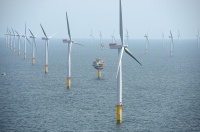No edit summary |
No edit summary |
||
| Line 4: | Line 4: | ||
</ul> | </ul> | ||
<div class="tab-content"> | |||
<div id="tab1" class="tab-pane fade in active"> | |||
[[File:Wind_Farm_Example.webm|750px|start=.75]] | [[File:Wind_Farm_Example.webm|750px|start=.75]] | ||
| Line 36: | Line 36: | ||
</div> | </div> | ||
<div id="tab2" class="tab-pane fade | <div id="tab2" class="tab-pane fade"> | ||
===PLACE ADDITIONAL CONTENT HERE=== | ===PLACE ADDITIONAL CONTENT HERE=== | ||
</div> | </div> | ||
</div> | </div> | ||
Revision as of 10:28, 5 March 2018
 | |
| Layer Info | |
|---|---|
| Category | Energy |
| Editable | Yes |
| DataOwner | Unknown |
| Placement Min | 0m |
| Placement Max | -150m |
| Production Min | x MWh/KM2 |
| Production Max | x MWh/KM2 |
| Resource Required | Wind_Speed |
| Types | |
| TypeTemplate | |
Description:
Offshore wind power or offshore wind energy is the use of wind farms constructed in bodies of water, usually in the ocean on the continental shelf, to harvest wind energy to generate electricity. Higher wind speeds are available offshore compared to on land, so offshore wind power’s contribution in terms of electricity supplied is higher,[1] and NIMBY opposition to construction is usually much weaker. Unlike the typical usage of the term "offshore" in the marine industry, offshore wind power includes inshore water areas such as lakes, fjords and sheltered coastal areas, utilizing traditional fixed-bottom wind turbine technologies, as well as deeper-water areas utilizing floating wind turbines.
MSP Challenge 2050:
Within the MSP Challenge
 Co-funded by the European Union.
Co-funded by the European Union.